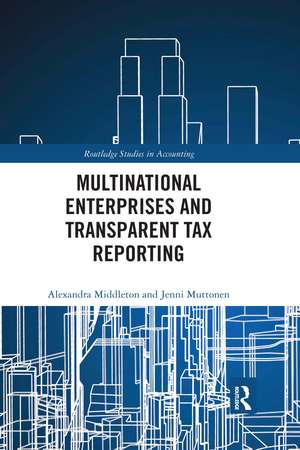Multinational Enterprises and Transparent Tax Reporting: Routledge Studies in Accounting
Autor Alexandra Middleton, Jenni Muttonenen Limba Engleză Paperback – 30 sep 2021
In this book, tax transparency is placed in a historical context and possible drivers and hindering factors to tax transparency are investigated. Tax transparency is discussed in the light of socio-economic theories (stakeholder, legitimacy, institutional theory and reputation risk management), as well as economic theories (agency theory, signalling, proprietary costs) and information overload theory. The book provides examples of tax transparency development of the largest multinational enterprises in five countries (France, Germany, UK, Finland and USA) in six years, 2012–2017, a period featuring increased media coverage of tax matters and legislative movement in the OECD and the European Union. The future of tax transparency is discussed in light of quality characteristics, assurance of information and potential use of artificial intelligence.
Companies’ managers and tax and CSR specialists benefit from the book by gaining insight into how to design transparent, high-quality tax reporting. Assurance professionals can use information about the quality criteria of tax transparency. Regulators can track historical development and see examples of voluntary tax transparency in companies’ reporting. Scholars and students obtain theoretical framework for analysing the tax transparency phenomenon and the ability to distinguish between the concepts of tax transparency, planning, avoidance and evasion.
| Toate formatele și edițiile | Preț | Express |
|---|---|---|
| Paperback (1) | 379.48 lei 6-8 săpt. | |
| Taylor & Francis – 30 sep 2021 | 379.48 lei 6-8 săpt. | |
| Hardback (1) | 934.00 lei 3-5 săpt. | +17.11 lei 4-10 zile |
| Taylor & Francis – 22 ian 2020 | 934.00 lei 3-5 săpt. | +17.11 lei 4-10 zile |
Din seria Routledge Studies in Accounting
-
 Preț: 322.14 lei
Preț: 322.14 lei - 8%
 Preț: 400.14 lei
Preț: 400.14 lei - 9%
 Preț: 934.00 lei
Preț: 934.00 lei - 9%
 Preț: 934.96 lei
Preț: 934.96 lei -
 Preț: 294.74 lei
Preț: 294.74 lei -
 Preț: 663.93 lei
Preț: 663.93 lei -
 Preț: 340.65 lei
Preț: 340.65 lei -
 Preț: 326.56 lei
Preț: 326.56 lei - 9%
 Preț: 1003.54 lei
Preț: 1003.54 lei - 17%
 Preț: 259.98 lei
Preț: 259.98 lei -
 Preț: 500.25 lei
Preț: 500.25 lei - 31%
 Preț: 767.07 lei
Preț: 767.07 lei - 26%
 Preț: 764.20 lei
Preț: 764.20 lei -
 Preț: 434.45 lei
Preț: 434.45 lei -
 Preț: 406.59 lei
Preț: 406.59 lei -
 Preț: 426.17 lei
Preț: 426.17 lei -
 Preț: 415.24 lei
Preț: 415.24 lei - 13%
 Preț: 296.19 lei
Preț: 296.19 lei - 26%
 Preț: 764.20 lei
Preț: 764.20 lei -
 Preț: 382.36 lei
Preț: 382.36 lei - 18%
 Preț: 1058.43 lei
Preț: 1058.43 lei -
 Preț: 116.67 lei
Preț: 116.67 lei - 18%
 Preț: 1000.27 lei
Preț: 1000.27 lei - 18%
 Preț: 1008.97 lei
Preț: 1008.97 lei - 28%
 Preț: 818.28 lei
Preț: 818.28 lei - 17%
 Preț: 321.08 lei
Preț: 321.08 lei - 18%
 Preț: 1215.71 lei
Preț: 1215.71 lei - 31%
 Preț: 764.20 lei
Preț: 764.20 lei - 18%
 Preț: 1165.24 lei
Preț: 1165.24 lei -
 Preț: 420.08 lei
Preț: 420.08 lei - 18%
 Preț: 1548.19 lei
Preț: 1548.19 lei - 18%
 Preț: 1001.07 lei
Preț: 1001.07 lei - 14%
 Preț: 299.03 lei
Preț: 299.03 lei -
 Preț: 436.14 lei
Preț: 436.14 lei -
 Preț: 386.81 lei
Preț: 386.81 lei - 28%
 Preț: 819.09 lei
Preț: 819.09 lei - 18%
 Preț: 998.71 lei
Preț: 998.71 lei - 18%
 Preț: 1106.02 lei
Preț: 1106.02 lei -
 Preț: 478.71 lei
Preț: 478.71 lei -
 Preț: 438.09 lei
Preț: 438.09 lei
Preț: 379.48 lei
Nou
Puncte Express: 569
Preț estimativ în valută:
72.64€ • 78.93$ • 61.05£
72.64€ • 78.93$ • 61.05£
Carte tipărită la comandă
Livrare economică 21 aprilie-05 mai
Preluare comenzi: 021 569.72.76
Specificații
ISBN-13: 9781032175713
ISBN-10: 1032175710
Pagini: 144
Ilustrații: 16 Illustrations, black and white
Dimensiuni: 156 x 234 x 8 mm
Greutate: 0.21 kg
Ediția:1
Editura: Taylor & Francis
Colecția Routledge
Seria Routledge Studies in Accounting
Locul publicării:Oxford, United Kingdom
ISBN-10: 1032175710
Pagini: 144
Ilustrații: 16 Illustrations, black and white
Dimensiuni: 156 x 234 x 8 mm
Greutate: 0.21 kg
Ediția:1
Editura: Taylor & Francis
Colecția Routledge
Seria Routledge Studies in Accounting
Locul publicării:Oxford, United Kingdom
Public țintă
Postgraduate and UndergraduateCuprins
1: Overview of the corporate social responsibility (CSR) and tax landscape 2. Defining Tax Transparency 3. Drivers and theories behind tax transparency 4. Current status of tax transparency in CSR reporting 5. Future of tax transparency
Notă biografică
Alexandra Middleton is an assistant professor with a PhD in financial accounting from the University of Oulu, Finland. Her research interests include tax transparency, CSR and sustainable business development in the Arctic.
Jenni Muttonen is an assurance professional working in financial and sustainability audits. She holds a master of science in economics and business administration from the University of Oulu, Finland, and a master of arts in international relations from the University of St Andrews, UK.
Descriere
This book addresses the phenomenon of tax transparency by multinational enterprises, setting it apart from tax avoidance and tax evasion. In this book, tax transparency is placed in a historical background and is contextualized by investigating the possible drivers and hindering factors to tax transparency.
